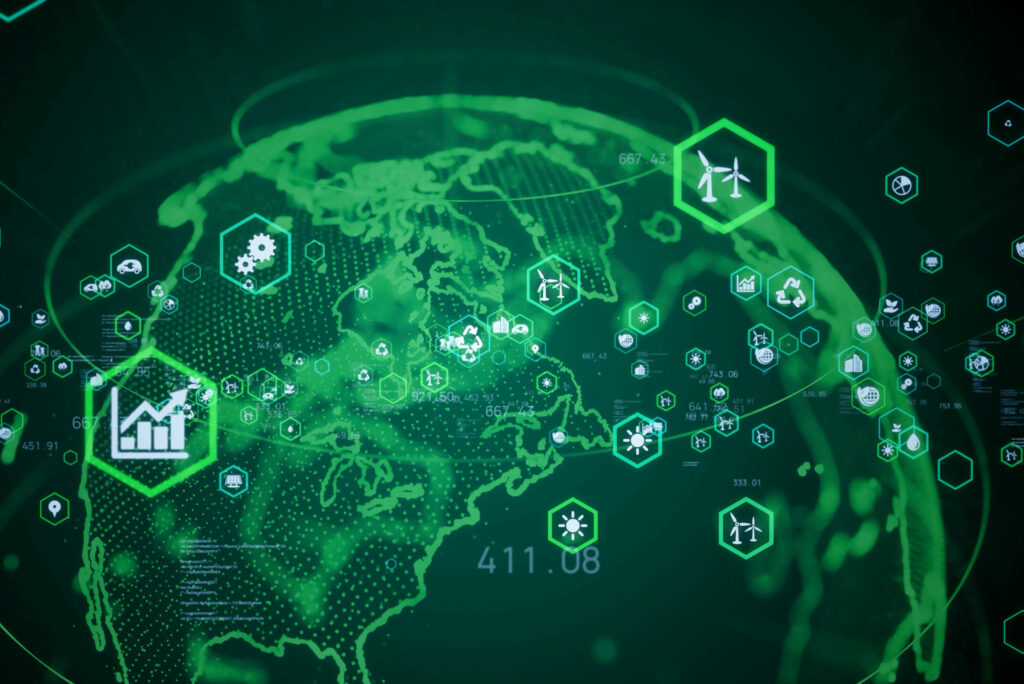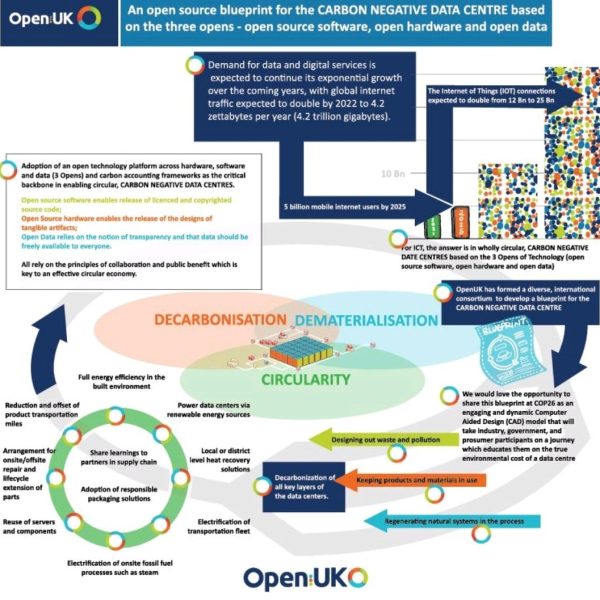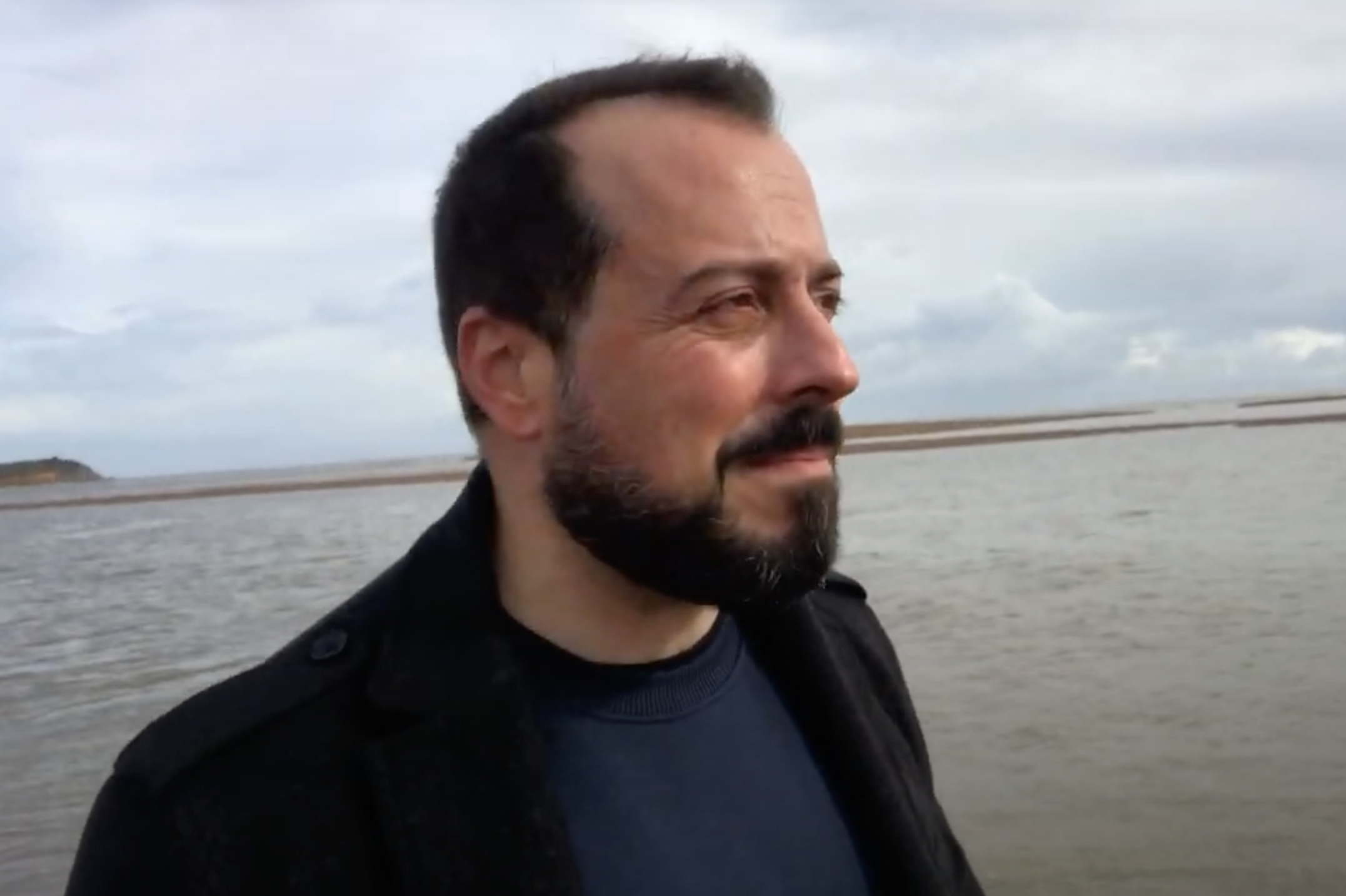
An ambitious blueprint has been unveiled by a consortium of companies for a carbon-negative data centre of the future, addressing the sustainability issues that come with the colossal growth of data. Tech For Good speaks to the team behind the plan
Data centres are already responsible for a vast amount of global energy consumption as well as considerable carbon emissions, and experts say this is poised to increase exponentially.
The proliferation of data and connected devices alongside a rapidly growing demand for information services and compute-intensive applications such as AI means that sheer demand will begin to offset the efficiency gains that have historically kept data centre energy use in check.
Until now, the information and communications technology (ICT) ecosystem’s electricity consumption has stayed nearly flat, while energy usage and carbon emissions have been kept in check by proactive changes such as ditching older facilities in favour of ultra-efficient and greener and more modern data centres, but that is no longer going to be enough.
According to most scientific modelling, the best-case scenario is that ICT energy consumption will grow to around 8% of all energy use by 2030, but if growth occurs at the rate most scientific models are predicting, it could be more like 20% – with data centres using more than one-third of that. Moreover, the amount of data needing to be stored is growing at a compound annual rate of 10.6% per year, according to the latest figures. As data multiplies, so do carbon emissions resulting from the need for that data to be housed somewhere.
So, how can all of this be dealt with?
Step forward a highly ambitious and innovative new proposal for a carbon-negative data centre based on a circular model focused on both decarbonisation and dematerialisation.
The blueprint, released by a consortium headed up by OpenUK, proposes an edge-enabled, 5G-based data centre model focused on sustainability, alternative energy sources and circular economy.
OpenUK’s new sustainability chief Cristian Parrino spoke to Tech For Good about the exciting plans for what the group is calling the “data centre of the future”.
The consortium behind the blueprint currently includes OpenUK, the Sustainable Digital Infrastructure Alliance, ITRenew, OpenCompute, Octopus Centre for Net Zero, and the Scottish 5G Centre.
Parrino is hopeful that by having such a forward-thinking group of partners onboard, they can tackle this problem at its root by targeting all key stakeholders and forcing them to think differently.
“One of my biggest frustrations in the environmental sustainability world is that environmentalists are the first ones to latch onto science when it comes to climate change, but they’re also the first ones to forget about science when it comes to behaviour change,” says Parrino.

“It has been proven time and time again that raising awareness of something doesn’t lead to changing individual behaviours. Nobel Prize-level researchers [Thaler and Kahneman, the so-called grandfathers of behavioural economics] have indeed demonstrated how one doesn’t lead to the other.
“Behaviour change requires making the desired behaviour more compelling or just as compelling as the alternative negative behaviour, and just as easy, if not easier, than the alternative competitive behaviour. And you need a mechanic to help people repeat that behaviour enough times so it becomes part of your regular routine. Only then is that behaviour actually changed.
“So, when we talk about carbon-negative data centres, this isn’t just for those who build data centres or use data centre services – this is also for your prosumer, your consumer and your regulators. It is basically something that everyone needs to look at because the data behind it is enormous, and perpetual growth and the desire for it is obviously a driving factor.”
Clearly, the group behind the proposal believes this blueprint is both scalable and readily adoptable enough to become that ‘mechanic’ Parrino speaks of.
“Driving real change hinges on great leadership, it’s not a management problem,” says Lucy Yu, CEO at Octopus Centre for Net Zero. Having a real cause to believe in and get behind and to ignite people’s intrinsic motivation is one of the things that helps leaders build brilliant teams and movements for change.”
Parrino’s views and concerns over the issue are reflective of the fact that more data, as mentioned earlier, equals more emissions.
Parrino is also keen to point out that most organisations focus only on Scope 1 (direct emissions from owned or controlled sources) and Scope 2 (indirect emissions from the generation of purchased electricity, steam, heating and cooling) sources while ignoring Scope 3, which includes all other indirect emissions that occur in a company’s value chain
“Many people in technology jump straight into the solution. I like to start with the problem and helping people understand how big the problem actually is,” says Parrino, as he begins to talk us through the graphic detailing the blueprint.


“One of my biggest frustrations in the environmental sustainability world is that environmentalists are the first ones to latch onto science when it comes to climate change, but they're also the first ones to forget about science when it comes to behaviour change,” - Christian Parrino
“That very first dark blue rectangle at the top, under the title, is really framing the problem. And the problem is the exponential growth that we’re going to be seeing in data services over the next few years. And it’s basically doubling every couple of years.
“The reason why it’s doubling is because there are more connected devices, be that from the IoT space, that’s just meant to double over a few years. If you just want to hone in on the narrow emissions aspect, over the next few years, by 2025, I think we’ll be at around 8% of emissions just from data centres and their supply chains. So, it won’t be long beyond that where we get to 10%.
“And that’s another key point. Most organisations out there are looking at Scope 1 and Scope 2, the emissions from energy consumption that your operation generates. So, electric usage, heat, all of that – those amount to like, 5% of the overall emissions of a data centre. 95% is their Scope 3, which includes the entire supply chain.
“Imagine having to not just decarbonise but also dematerialise through a circular model an entire supply chain around the data centre. It’s a massive thing! Then, imagine the role something like open software, open data and open hardware can play in achieving that.”
Parrino naturally segways to where the open source element of the plan comes to the fore and he credits the whole idea to OpenUK CEO Amanda Brock, who previously spoke to Tech For Good last year about bringing the open source community together in response to the pandemic.
The plan emerged during a call between the pair just over seven months ago, and then Parrino and Brock began to leverage their respective contacts and expertise they could tap into to make the blueprint a reality.
The pair brought together experts who could help with different aspects of the project, such as California-based ITRenew who do a lot of work with the hyper scalers, circular hardware and services; the Open Compute Project which has done a lot of the research behind carbon-negative data centres; the SDA Alliance which is doing similar things in the Netherlands; Octopus Energy who recently created a new foundation to look at innovation in the green energy space.
“We have the tools, the technology, the systems and the solutions to transform the way we build, deploy, and manage the massive and booming scale IT and data centre infrastructure,” says Ali Fenn, President of ITRenew.
Very quickly, the roadmap and vision for the carbon-negative data centre came together, and the role of the three opens (software, hardware and data) is right at the heart of making it work.
“There’s a lot included in this vision for a carbon-negative data centre,” Parrino says. “In terms of hardware, if it’s open-source, it means organisations could produce it locally and eliminate travel times behind the supply chain. It also means that they can repair it and it means that when it reaches end of life, they can recycle components because the planet has a limited set of minerals to meet this increase in demand for hardware around the world.
“In terms of data, consider for a minute the amount of transparency that you require to understand whether a data centre is truly clean or not. What about the 95% of emissions that are part of the supply chain?
“So, imagine the role open data and open-source software can take on to enable transparency and accountability around emission monitoring, carbon monitoring and all of that. If all of a sudden it comes back down to people like you and me, and I want to use services that are backed by carbon-negative data centres, that would be an easy way for me to know who’s clean and who’s not.
“And then, the other role that open has is obviously learning and sharing best practises. There’s a lot of stuff going on already, with the hyperscalers and ‘greening’ the data centre. But why is everybody trying to reinvent the wheel every time? Why isn’t that knowledge shared? Why isn’t it public? Why isn’t it transparent? Why can’t a small government cell phone data centre somewhere in Scotland go and do the same thing the hyperscalers are doing because it needs to happen in a proliferated way?
“If you look at those different aspects of software data and hardware, I think open technology per se is essential in the sustainability world. It is absolutely essential in carbon-negative data centre solution, which is why we’re creating that blueprint. It’s a blueprint that adopts open technology, hardware, data and software wherever possible.”

This will even extend to things like potentially working with cities to use existing infrastructure instead of constructing anew, and even repurposing derelict or simply unused buildings. The blueprint also seeks to leverage emerging technologies such as edge computing and 5G to help narrow the distance on computation and servicing, which is also critical in lowering emissions.
It all ties into the circularity of the model, which is made clear by the diagram, and the team behind are looking at concepts such as using the heat generated by the data centre and looking to feed that back into the power grid.
What certainly rings true when chatting with Parrino is that this plan is very much looking at the overall societal impact as well. It is thinking of sustainability, not just as a climate change or environmental issue but very much as a social inclusion and financial inclusion issue as well.
That ties in very much with the United Nations’ Sustainable Development Goals and Parrino points out that goal 17, which he cites as “the most commonly forgotten” is “working in partnership” to reach the rest of the goals.
The carbon-negative data centre roadmap appears to have come together at a serendipitous time, with the 2021 United Nations Climate Change Conference of the Parties (COP26) being held in Glasgow in November. The consortium has submitted its proposal and is hoping to be chosen to present at the iMax cinema to allow them to showcase their blueprint at the conference, but also plans to showcase at the COP26 Fringe event if they are unable to make the shortlist.
Parrino, who has been passionate about sustainability ever since he saw the values of the daily life he grew up around in Sicily gradually erode away over the years, is a firm believer in the concept and enthusiastic at the potential prospect of being able to showcase it to the world at the conference.
“COP26 is that moment in time that can magnify something a hundred-fold, a thousand-fold,” he says. “There’s attention to it, there’s a concentration of minds, there’s a concentration of funds, so from that perspective, it’s essential to leverage COP26, both in the build-up, during the event itself and in the aftermath.
“If we can achieve circularity and 90% dematerialisation, we will also achieve 80% decarbonisation while, at the same time, looking at some positive impact aspects. Things like reducing costs and accessibility of solutions, be those blueprint-related, hardware-related or software-related to less privileged countries. Also bringing excess heat and energy created to communities which need it.
“There’s an eliminating the negative impact side of the story, but there’s also a creating positive impact part of the story.”



